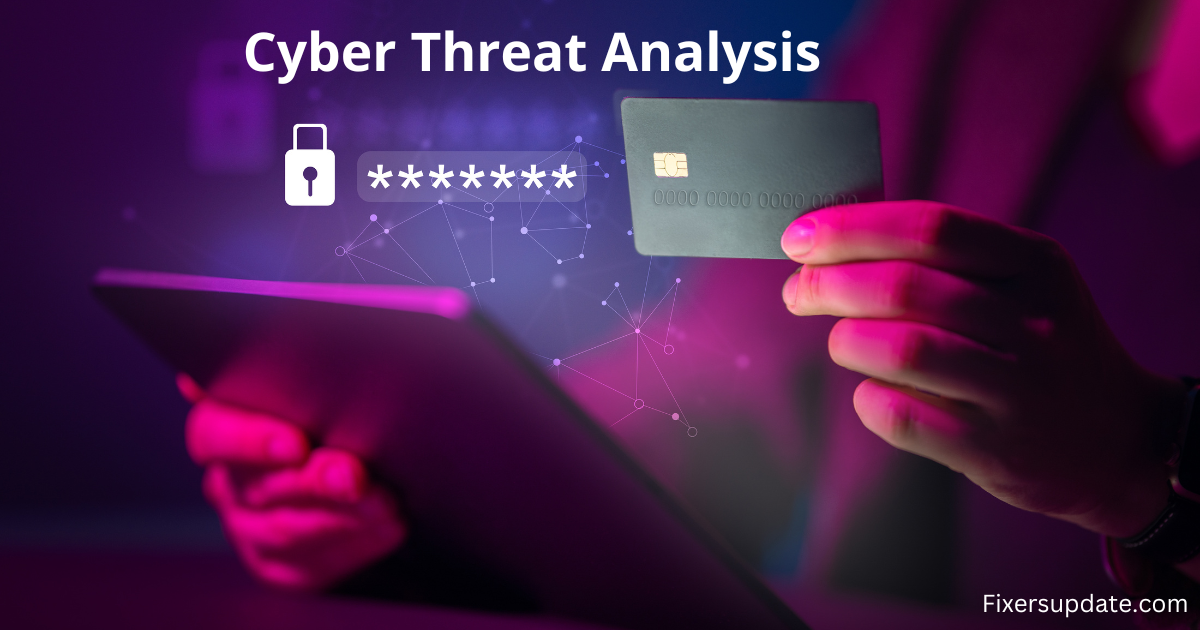With the increasing digital landscape, having Cybersecurity Threat Analysis is inevitable to safeguard organizations against online threats. Knowing what the various threat families are and what to do with this information, companies can keep one step ahead of opportunistic cyber attackers.
This post explores the critical need for cyber threat analysis. It covers the types of cyber threats to know and best practices for analyzing them. We will take a look at some tools that may come in handy for this deep analysis. If you want to be a cyber threat analyst or improve security, you’re in the right place!
Key Takeaways
- Know Your Threats: Analysis and protection are incomplete if you do not understand the different types of cyber threats we face.
- Importance of Analysis: Cyber threat analysis is a major function for any aspect of cybersecurity providing many useful insights such as pre-discovery and prevention parameters.
- The Analysis Process: Cyber threat analysis includes steps such as identification of threats; data collection, and creation of an articulate response to threats. This analysis could be made through threat metrics and models among others.


Introduction to Cyber Threat Analysis
It can be considered a safety check for the digital world termed Cyber threat analysis. It is a practice where companies keep an eye on possible cyber dangers that could cripple their system, network, or even the entire operation. This process of data analysis, security intelligence, and investigative procedures serves to assess and categorize the likelihood and potential severity of such threats.
Cyber threats are increasingly becoming complex and sophisticated, and organizations need to watch their step instead of reacting later. It will be too late if you wait for a cyber attack to actually happen. It can cost the company significantly and tarnish the reputation of companies for years. Cyber threat analysis can help businesses predict possible threats and mitigate risk before it causes harm.
Cyber threat analysis is necessary for proper cybersecurity because it helps:
- Spotting Suspicious Activity: Recognizing trends of behavior that seem to take the form of a threat.
- Identifying Security Vulnerabilities: Spotting the areas where the system lacks encryption.
- Future Attacks Forecast: Applying historical data to predict likely future threats.
- Threat Actor Detection: The process of uncovering specific beings or organizations bluntly attempting to strike your entity, usually the ones who hang out on the dark web.
- Recon and Phishing: Knowing How They Could Come for You.
In this digital-centric world, companies need to have specialist knowledge of cyber threat analysis as we are all aware that it’s not a question of “if” but “when”. It is one of the tools used for keeping sensitive data safe and navigating the vast world of online security.
Cyber Threat Analysis in Today’s Digital World
Businesses cannot afford to ignore cybersecurity threats in the modern digital age where every entity from small businesses to large corporations is vulnerable to ransomware, phishing attacks, and some actors spearheading advanced persistent threat campaigns using more sophisticated attack vectors.
With the heavy touch of technology in operations in organizations, the impact of these cyber incidents can be disruptive as it causes data breaches and leads to financial loss, damage to reputation, and legal issues.
Cyber Threat Analysis is essential for several reasons:
| Reason | Description |
|---|---|
| Proactive Defense | In this approach, when organizations know what is a realistic threat, they can adopt preemptive measures to minimize their surface for an attack. |
| Informed Decision-Making | The result of such analysis helps in making decisions for security investments and resource allocation. |
| Compliance & Regulations | Many industries are under strict regulations requiring strong security. Organizations use cyber threat analysis to meet these regulatory demands. |
| Enhancing Security Posture | Constant monitoring enables organizations to adjust defensive strategies and ensure protection from cyber threats, as the threat landscape is ever-changing. |
| Crisis Management | Structured threat analysis ensures faster detection, response, and recovery in the event of a security incident, leading to less downtime and damage. |
Understanding Cyber Threat Analysis
Given that we are ever more dependent on technology in both our personal as well business worlds, you can consider cybersecurity an important issue. Cyber threat analysis is one of the key components of a powerful security strategy.
Cyber Threat Analysis vs. Risk Analysis
Cyber Threat Analysis Vs Risk Analysis fire Event Cyber Threat Analysis and Risk Analysis is considered to be two sides of the same coin, yet they serve completely different motives in an agile cybersecurity framework within an organization.
Cyber Threat Analysis means to categorize the specific threats and vulnerabilities that can hit the firm. This requires gathering information about threat actors, their tactics, techniques, and procedures (TTPs), and what the potential outcome of attacks based on these is.
On the other hand, Risk Analysis dives into all risks in their totality by analyzing threats based on how often they will occur and what influence could bring to the organization. It considers various factors such as external threats, internal security holes, and measures that have been implemented but also the business processes running at stake.
Essentially, Cyber Threat Analysis is a form of Risk Analysis, it provides all the information and context you need to analyze risk effectively.


Types of Cyber Threats
In order to perform an effective Cyber Threat Analysis, it becomes essential that you learn about various types of cyber threats. These can range from the following;
| Threat Type | Description |
|---|---|
| Malware | Malicious software designed to disrupt, damage, or gain unauthorized access to computer systems, including viruses, ransomware, and spyware. |
| Phishing | Fraudulent attempts to obtain sensitive information such as usernames, passwords, and credit card details by disguising as a trustworthy entity in electronic communications. |
| Denial of Service (DoS) | Attacks are aimed at overwhelming a system’s resources, causing downtime, and making services unavailable to users. |
| Man-in-the-Middle (MitM) | Intercepting and altering communication between two parties without their knowledge to steal data or inject malicious content. |
| SQL Injection | Inserting malicious SQL code into a query, allowing attackers to manipulate databases and gain unauthorized access to sensitive information. |
| Zero-Day Exploits | Taking advantage of software vulnerabilities before the vendor becomes aware and patches the issue, makes it particularly dangerous. |
| Advanced Persistent Threats (APTs) | Sustained cyber attacks where attackers gain unauthorized access and remain undetected for long periods, often targeting high-value information. |
| Insider Threats | Threats originating from individuals within the organization, either maliciously or accidentally, can lead to data breaches or system compromises. |
| Ransomware | A type of malware that encrypts files on a device, with the attacker demanding a ransom payment for the decryption key. |
| Social Engineering | Manipulating individuals into divulging confidential information or performing actions that compromise security, such as revealing passwords. |
Important Elements of Cyber Threat Analysis
There are several components that make up Cyber Threat Analysis along with how they work together to give a full insight into the potential threats.
- Threat Intelligence Gathering: Including data scouting from open-source intelligence (OSINT), threat intelligence feed, industry reports, and dark web monitoring This is very essential in order to understand the landscape of threat.
- Threat Evaluation: Analysts assess identified threats to determine threat credibility, and accordingly the urgency and importance of the response plan into one or more ‘severity’ categories.
- Analyze Threats in Context / Predict: This phase is where traditional threat analysis plays a part. It does not exist in isolation but takes the organization’s specific environment into account; its vulnerabilities, attack vectors, industry trends, etc.. Using historical data, the predictive analysis predicts future threats.
- Develop threat mitigation strategy: After the analysis is completed, the organization creates strategies that help in mitigating the identified threats; this may include – which includes implementing security controls, training employees, and an incident response plan.
Core Components of Cyber Threat Analysis
Given its focus on predictive analysis, the first key component of Cyber Threat Analysis is the threat intelligence gathering. This process whereby data from multiple sources is collected can be achieved by:
Threat Intelligence Gathering
Given its focus on predictive analysis, the first key component of Cyber Threat Analysis is the threat intelligence gathering. This process whereby data from multiple sources is collected can be achieved by:
Open Source Intelligence
Publicly available information such as news articles, social media, and blogs can provide insights into emerging threats and trends.
Threat Intelligence Feeds
Many organizations are subscribers of commercial threat intelligence feeds that provide up-to-date information on newly identified vulnerabilities, malware signatures, and threat actor activity.
Industry Reports
Reports published by various cybersecurity firms industry associations and the government can offer insights into the threat landscape and best assessments.
Dark Web Monitoring
Monitoring of dark web forums and marketplaces to identify stolen data, planned attacks, or conversations that mention the organizations.
Threat Evaluation
Once the data has been collected, the analyst must assess the credibility and potential impact of a given threat. This entails examining.
Threat Actor Capabilities
The analyst must determine what an attacker could potentially accomplish.
Vulnerability Analysis
The analyst should investigate which of the organization’s known vulnerabilities are most applicable and the most likely to be exploited.


Contextual and Predictive Analysis
Contextual analysis is assessing the relevancy of the potential threats gathered in respect of the organization. The parameters used in this assessment might include:
- Business Processes: knowledge of how an organization’s processes work is critical to identifying the most important assets that need protecting.
- Industry Trends: I like understanding what it is the attackers shot at most often or what failures happen most frequently.
While predictive analysis is “guessing” at the threats an organization might face based on past data. This information includes patterns observed and stands a much higher chance of being wrong because the data is scarce.
The Threat Mitigation Strategy Development
The final component of Cyber Threat Analysis is the apportioning of measures to protect against scoping threats. These measures might include:
- Security Controls: After the analysis, an organization might install firewalls, intrusion detection systems, and malware protection suites to shield from scoping threats.
- Employee Training: Routine training keeps employees “knowledgeable” about cyber threats and their importance, whether that be about phishing attacks, cyberattacks, or any other threats.
Incident Response Planning Organizations are encouraged to develop and maintain an incident handle plan, but also to update plans when necessary, so the organization can quickly respond and resolve the incident appropriately once it occurs.
Cyber Threat Analysis Tools
There a multiple sets of tools and platforms that are used to perform Cyber Threat Analysis for the organizations. Some common categories and examples include:
| Tool Category | Examples | Description |
|---|---|---|
| Threat Intelligence Platforms | ThreatConnect, Recorded Future | These platforms pull in threat data from various sources and offer intelligence that can be analyzed to help organizations make better decisions. |
| SIEM (Security Information and Event Management) | Splunk, IBM QRadar | SIEM tools monitor security information from multiple sources, enabling live threat responses by the organization. |
| Vulnerability Management Solutions | Qualys, Nessus | These tools scan systems and applications for known vulnerabilities, helping companies identify security holes and determine necessary updates. |
| Incident Response Tools | PagerDuty, ServiceNow | These tools empower organizations to efficiently manage security incidents, enabling faster and more effective resolution. |
Most Frequent Asked Questions
What is threat analysis in cybersecurity?
Threat analysis is the process of discovering and evaluating potential cyber threats to shield an organization’s systems (systems) and knowledge(I data ) from being disturbed.
What are the four stages of threat analysis?
Four stages usually are comprised of threat identification, intelligence analysis, threat assessment & prioritization, and mitigation planning.
What are the four types of cyber threats?
Some common types are malware, phishing, ransomware, and denial of service attacks.
What are the threats of attack analysis?
It is the examination of concrete threat behavior in order to understand how likely and resulting damage such an incident could be. This way it can be prepared for, defenses built to mitigate such attacks
Conclusion
- There is more to your cybersecurity than taking measures when there occurs a cyber event; it involves predictive analysis providing your organization with the strength to fight back even before the attackers get successful in making an attack.
- Understanding the threats and taking advantage of an effective analysis allows businesses to protect their data and keep operations safe.
- Mastering the art of cyber threat analysis will help to detect almost any cyber security threat, as threats continue to evolve and become increasingly difficult to manage.










